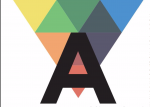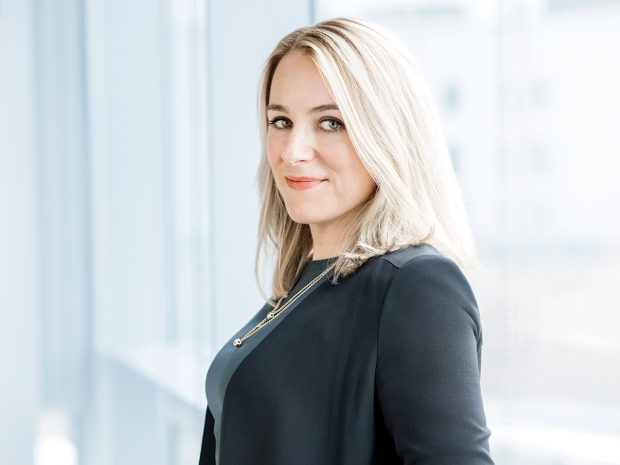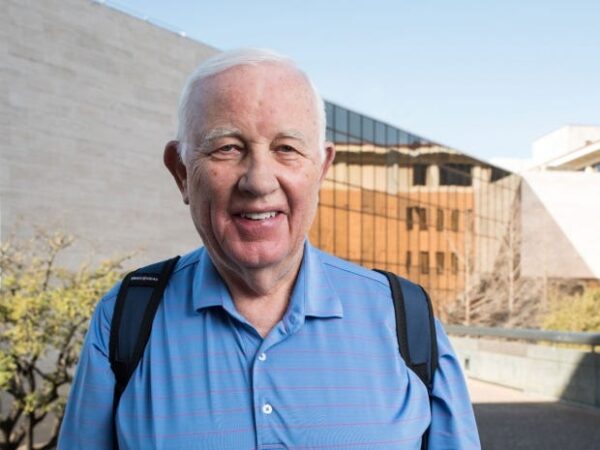An Interview with Slack’s April Underwood
How skillful management took this champion connector to Google, Twitter, and beyond.
By Cynthia Hanson


APRIL UNDERWOOD, BBA ’01, is proof of the power of personal connections. As an undergraduate Business Honors major, she leveraged a chance meeting with 3M’s Tina Beamer, BBA ’93, to land a summer internship writing code and building software. It was an experience that set the stage for Underwood’s early career in product management and engineering at big names in Silicon Valley, among them Travelocity, Google, and Twitter. During the social media company’s explosive growth from startup to IPO, she was a key player, developing both the breakthrough Tweet button and Twitter API.

Fast forward to 2015. After leaving Twitter, Underwood turned a meeting with tech entrepreneur Stewart Butterfield into a role as vice president of platform at Slack, Butterfield’s $3.8 billion collaboration startup. Slack’s features include direct messaging, file sharing, and search, with both open channels for sharing information to an entire team to custom channels where a few individuals can hold more private conversations. Slack aspires to be the messaging platform of choice for teams of any size — whether at a dentist’s office or a Fortune 500 company. “It’s an audacious goal, and it’s going to take a lot of work,” acknowledges Underwood, who holds an MBA from the University of California, Berkeley. Today, she is Slack’s vice president of product, a role that plays to her sweet spot of product vision, platform development, strategic partnerships, and API integrations. Her leadership has already been felt: This January, the 800-employee company launched Slack Enterprise Grid, a product designed for large teams that’s meant to expand Slack’s reach beyond its current 5 million daily active users.
Underwood, who grew up in Texas, was a technology prodigy from the start. At 6 years old, she mastered using complex CAD software to draw straight lines on the computer — a task that confounded many of the students in her father’s architecture class at Amarillo Community College. By 10, Underwood created spreadsheets to catalog her vast collection of baseball cards, and as a high school senior, she wrote her first program. “I finished my computer class homework quickly, so I created a program that allowed me to compute my GPA,” she recalls. “I was a little obsessive about tracking my performance.” Now at age 37, Underwood is a Silicon Valley power player. She recently was named one of Fortune’s “40 Under 40” and one of the “Most Creative People of 2015” by Fast Company. And she believes in giving back: Underwood cofounded #Angels, an investment group composed of former and current female Twitter executives, to support early-stage companies. Since its launch in 2015, the group has invested nearly $3 million in more than 50 enterprises. We caught up with Underwood before the release of Slack Enterprise Grid to get her take on everything from the benefits of a well-rounded business education to different types of connections — and why the face-to-face relationships that helped launch her career remain vital in our tech-driven world.
What drew you to studying business at McCombs?
I started at UT as a chemical engineering major. I had enjoyed AP chemistry in high school, but after a semester, I realized chemical engineering wasn’t for me. A friend in my dorm opened my eyes to McCombs. I didn’t know anything about business majors, but once I learned about the curriculum, I got pretty excited and applied for the Business Honors Program in my sophomore year. I got accepted and gave up my engineering scholarship. College was a financial burden for my family, and I was lucky to earn scholarships from McCombs after I’d been there a year. It was critical for me to complete my education without racking up a lot of debt, and I graduated in three and a half years.

You have achieved success in a highly competitive and evolving industry. Besides technical ability and hard work, what personal attributes contributed to your rise?
My strong communication skills — both written and verbal — allowed me to stand out. I started as a software engineer and moved into product management, which is an inherently cross-functional role. You need to understand technology, create a vision for the future, and get your team, managers, and customers excited about it.
You have to clearly communicate ideas and have the confidence and strength to set ambitious goals for your team.
The McCombs curriculum, with courses in finance, marketing, and communications, gave me a well-rounded skill set and the exposure I needed to succeed.
In addition to giving the world the Tweet button, you led Twitter during a period of incredible growth — going from 150 to 4,000 employees in five years. Managing growth is an accomplishment in and of itself.
We were constantly changing the way we did things because what works with 200 employees doesn’t work with 400 or 800. I’m also proud of the work I did on ad production, which helped Twitter build an incredible business around advertising and facilitated Twitter’s going public in 2013.
What are some of the ways that Twitter enables business and personal connections that would not exist otherwise?
Twitter allows you to hear directly from anyone in an unfiltered way. Businesses can receive feedback directly from customers. At Slack, we read and reply to every question and comment we get on Twitter. It’s an invaluable source of feedback — both good and bad — that helps us understand our customers better. As a professional, Twitter allows me to follow other execs at companies in my industry. People like Aaron Levie, CEO of Box, and Patrick Collison, co-founder and CEO of Stripe, share openly about business, politics, and the world on Twitter. I get to engage with them in a way I would not on any other platform.
What motivated you to make the move to Slack?
I love the product. I use Slack to stay in touch with friends and former Twitter colleagues in the U.S. and Canada. When a couple of them went to work for companies that used Slack, they suggested we move our conversations from texting to there, and we never went back. It was a better experience than just texting; we were able to organize around different topics, and it had much better search capabilities to refer to a story or link. When I met [CEO] Stewart [Butterfield], he talked about his vision for the Slack platform. Platforms are my bread and butter. What I love is the unique opportunity to put my experience to use around a big business opportunity.
How did your previous jobs prepare you for your role at Slack?
The diversity of my experience — as an engineer, product manager, and marketing and business development leader — gave me a broad tool set from which to draw. Plus, I’ve worked at companies as small as 20 employees and as large as over 20,000 employees. The way you become prepared to take on new challenges is by training your brain to tackle new problems — and tackle them quickly. Use what you’ve learned and be open to the possibility that the way things worked at the last company — or in the last role — may not apply.
What differentiates Slack from other work project platforms?
It’s not just a communication program. It connects with the tools you use every day, like HR systems, or Google Drive, and systems engineers can even use it to create software. You can work with your colleagues to achieve your goals as a team, but it also ties together what can, at times, be an overwhelmingly siloed set of tools. Slack facilitates connections because it actually allows teams to do their best work and do it more efficiently.
The tech sector has a reputation for being difficult for women to break into. Who inspired you in your career path?
From early on, I never sensed there was a glass ceiling for women. I’ve been fortunate to work at companies with strong female leaders: At Travelocity, there was CEO Michelle Peluso [now CMO at IBM] and at Google, I looked up to Marissa Mayer [CEO at Yahoo], Sheryl Sandberg [COO at Facebook], and Susan Wojcicki [CEO at YouTube].
These days, I am lucky to have a close-knit network of women investors, executives, and founders of companies — I call them “friendtors.”
We look out for each other and help one another get access to great opportunities. I’m also fortunate to have a group of men and women who help me when I’m looking to hire or need advice. I turn to my six co-investors with #Angels, as well as the investors at Slack, our board members, and good friends from UT and my MBA program.
How do you see the convergence of big data, mobile, artificial intelligence, and other innovations changing how we connect? Any predictions?
Fortunately, machine learning and artificial intelligence are starting to achieve real utility in the workplace. Questions like, “What was our revenue on April 14?”and “Which engineer knows the most about this feature?” will be answered accurately and instantly with software. When you think about the sum of all of the time that knowledge workers spend retrieving information and answering questions that other people have already answered many times over, you can imagine just how much productivity can be redirected toward real creative pursuits. These technologies could significantly boost productivity and creativity for many people.
In a world of virtual connections, how have such innovations changed your workplace and personal behaviors, for better or worse?
Software supports, rather than replaces, human relationships in the workplace. When I worked at Twitter, I would often know a bit about a colleague’s life before I met him or her because of posts I’d seen on Twitter. That allowed me to connect on a much more personal level. Now, in my role at Slack, I hear from many executives who are looking to enhance culture within their companies. Slack allows employees to bring their whole selves to work by offering an environment where people not only get work done but also connect with colleagues around common interests. Here at Slack, we have channels for parenting, favorite movies (#starwars, of course), and political issues — all initiated in a grass-roots way by our employees. We also get work done! But we do so more easily because we don’t expect people to turn off their “authentic selves” when they get into the office or log into Slack.
What prompted you to launch #Angels? What types of companies are you targeting for investment in 2017?
Five of my Twitter colleagues and I realized we had an interest in helping support early-stage companies go through the type of amazing journey we’d experienced together. We back companies in a variety of categories, and each of us makes our own investment decisions. Health care is one particular area we see as ripe for technology-driven innovation. We’ve been delighted to back companies like Color Genomics, Forward, Nurx, and Hale Health.
What can business schools be doing better to prepare a new generation for the challenges and opportunities ahead?
Anything business schools can do to help reduce barriers for people starting their own businesses is really valuable. In Silicon Valley, there is the expectation that if you have an idea, you should go after it, because there will be ways to raise money and make it possible. Encouraging entrepreneurship is as important — or even more important — than the classwork itself.
Business schools need to facilitate ways for students to go figure things out. A lot of learning happens in just doing things and taking risks.
How do you act as a networker, mentor, or guide to others — and do you have a particular philosophy for exercising your influence?
I’m always looking for ways to guide men and women who are early in their careers, but I want to do so in a scalable way. I speak at UC Berkeley and UT when I can, and through #Angels I have facilitated events for executives or company founders who are so busy doing the work that they’re not taking the time to get to know other awesome women in the industry. Bringing together 20 to 40 women for an event — rather than reaching out one-on-one — allows me to help more women grow in their careers. But I don’t tell people I have it all figured out.
Cynthia Hanson, a journalist based outside Philadelphia, has written for The Wall Street Journal, Crain’s Chicago Business, and the Brown Alumni Monthly.
From the spring 2017 issue of McCOMBS, the magazine for alumni and friends of the McCombs School of Business.
Originally published at www.today.mccombs.utexas.edu.
http://www.today.mccombs.utexas.edu/2017/05/april-underwood-slack-interview-technology


